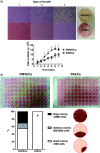Single cell cloning generates lung endothelial colonies with conserved growth, angiogenic, and bioenergetic characteristics
- PMID: 28841087
- PMCID: PMC5703126
- DOI: 10.1177/2045893217731295
Single cell cloning generates lung endothelial colonies with conserved growth, angiogenic, and bioenergetic characteristics
Abstract
Pulmonary artery, capillary, and vein endothelial cells possess distinctive structures and functions, which represent a form of vascular segment specific macroheterogeneity. However, within each of these segmental populations, individual cell functional variability represents a poorly characterized microheterogeneity. Here, we hypothesized that single cell clonogenic assays would reveal microheterogeneity among the parent cell population and enable isolation of highly representative cells with committed parental characteristics. To test this hypothesis, pulmonary microvascular endothelial cells (PMVECs) and pulmonary arterial endothelial cells (PAECs) were isolated from different Sprague Dawley rats. Serum stimulated proliferation of endothelial populations and single cell clonogenic potential were evaluated. In vitro Matrigel assays were utilized to analyze angiogenic potential and the Seahorse assay was used to evaluate bioenergetic profiles. PMVEC populations grew faster and had a higher proliferative potential than PAEC populations. Fewer PMVECs were needed to form networks on Matrigel when compared with PAECs. PMVECs primarily utilized aerobic glycolysis, while PAECs relied more heavily on oxidative phosphorylation, to support bioenergetic demands. Repeated single cell cloning and expansion of PAEC colonies generated homogeneous first-generation clones that were highly reflective of the parental population in terms of growth, angiogenic potential, and bioenergetic profiles. Repeated single cell cloning of the first-generation clones generated second-generation clones with increased proliferative potential while maintaining other parental characteristics. Second-generation clones were highly homogeneous populations. Thus, single cell cloning reveals microheterogeneity among the parent cell population and enables isolation of highly representative cells with parental characteristics.
Keywords: aerobic glycolysis; heterogeneity; metabolism; proliferation; pulmonary circulation.
Figures










References
-
- Fuchs A, Weibel ER. Morphometrische untersuchung der verteilung einer spezifischen cytoplasmatischen organelle in endothelzellen der ratte. Zeitschrift für Zellforschung und Mikroskopische Anatomie 1966; 73: 1–9. - PubMed
-
- Steinsiepe KF, Weibel ER. Electron microscopic studies on specific organelles of endothelial cells in the frog (Rana temporaria). Zeitschrift für Zellforschung und Mikroskopische Anatomie 1970; 108: 105–126. - PubMed
-
- Weibel ER. Fifty years of Weibel-Palade bodies: the discovery and early history of an enigmatic organelle of endothelial cells. J Thromb Haemost 2012; 10: 979–984. - PubMed
-
- Kelly JJ, Moore TM, Babal P, et al. Pulmonary microvascular and macrovascular endothelial cells: differential regulation of Ca2 + and permeability. Am J Physiol 1998; 274: L810–L819. - PubMed
Grants and funding
LinkOut - more resources
Full Text Sources
Other Literature Sources

